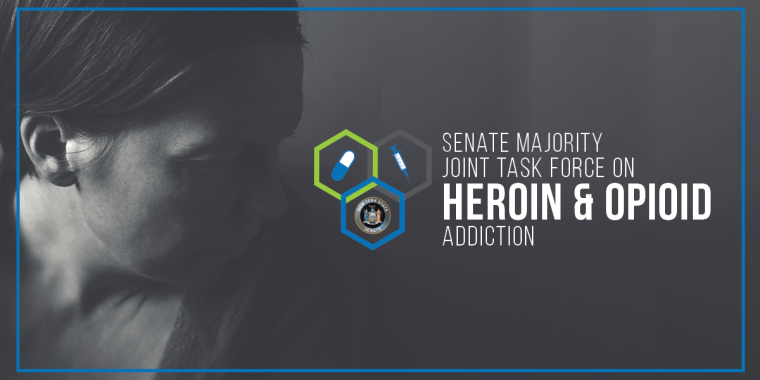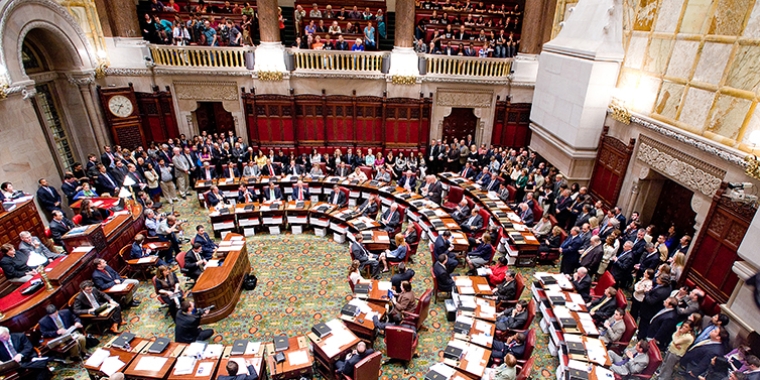
New York State Senate’s Joint Task Force On Heroin And Opioid Addiction Releases Report And Legislative Recommendations
May 18, 2016
-
ISSUE:
- Heroin and Opioid Addiction

The New York State Senate Joint Task Force on Heroin and Opioid Addiction today released a report summarizing findings and recommendations resulting from forums held across the state to address New York’s ongoing heroin epidemic. Senators Terrence Murphy (40th Senate District), Robert Ortt (62nd Senate District) and George Amedore (46th Senate District), the Co-Chairs of the Task Force, announced the report’s findings which include comprehensive legislative recommendations to address shortcomings in the state’s existing opioid prevention and treatment-delivery strategies.
In its report, the Task Force identified a four-pronged approach that would stem the growth of the heroin and opioid crisis - prying loose the stranglehold it has on New York’s communities - and supports those battling their addiction on the journey to recovery:
Prevention: increasing awareness to better educate the public of the inherent risks involved in using heroin and prescription opioids, and taking advantage of technological advances available to deter the abuse of prescription drugs and prevent addiction;
Treatment: recognizing the critical need for expanded and improved insurance coverage, and enhancing access to all forms of effective treatment - including inpatient, outpatient, and Medication Assisted Treatment - in order to help individuals return to stable and productive lives;
Recovery: providing the proper supports, such as safe environments, stable employment, and opportunities to participate in diversion programs that avoid incarceration in order to facilitate successful recoveries from addiction; and
Enforcement: implementing criminal justice reforms that give law enforcement the necessary tools to disrupt the supply of heroin and stop the diversion of opiate prescription medications within the state.
“This legislative package is representative of the multi-pronged approach that the Task Force presented in their comprehensive report. Acting now will set the tone for our state as we work to protect our communities from this epidemic and let parents know that they have a willing partner in the State of New York. I thank Senators Ortt, Amedore and Murphy for their work and hope the Assembly and Governor Cuomo will join us in this effort,” stated Senate Majority Leader John Flanagan.
Task Force Co-Chair Senator Ortt said, “This report represents the conclusion of over a year of traveling across the state - from Niagara to Long Island - and listening to those at the front lines of the heroin epidemic. Our recommendations incorporate the specific expertise from a broad array of community stakeholders - the heartbreaking stories from addicts and families, best practices from recovery and treatment specialists, preventative outreach from medical and education professionals, and enforcement tools for police officials. I'm hopeful that the Assembly and the Governor will join us to implement these legislative solutions to take back our communities and save lives. Although the report may be completed, let us be clear that as public officials and Chairs of the Task Force, our work on this critical issue will not cease.”
Task Force Co-Chair Senator Amedore said, “As we travelled the state to gather input on how best to address the heroin crisis, we heard the same concerns in communities all over the state: current insurance coverage for addiction is not adequate; we need to increase prevention efforts; more treatment and recovery services need to be available in all parts of the state; and law enforcement needs resources to get high level dealers off the streets. This four-pronged approach - prevention, treatment, recovery and enforcement - is the foundation for the report and recommendations we are releasing today. These recommendations will help so many throughout the state who are struggling with addiction.”
Task Force Co-Chair Senator Murphy said, “This report is the result of a statewide collaborative effort to offer solutions needed to combat, and ultimately win, New York's ongoing war on heroin and opioid addiction. The stories we heard were real, the pain we felt significant, and the desire to bring about the necessary changes to ensure our fellow New Yorkers receive the help and care they desperately deserve brought us to the four corners of our great State. It is abundantly clear that more needs to be done to expand treatment options; more needs to be done to educate our kids, fellow parents and prescribers; more needs to be done to improve and increase recovery services; and more needs to be done to support law enforcement's efforts. If there was ever an issue for my colleagues on both sides of the aisle to unite over this would be that very cause.”
Task Force Member Senator David Carlucci (38th Senate District) said, “Heroin and opioid addiction have become an epidemic across the Hudson Valley, and throughout New York State. We do not need to see statistics to know that this issue plagues our area - we only need to look towards the families that have lost their loved ones, and those that are struggling with this addiction every day. I have been proud to take the lead on this issue by hosting Naloxone trainings to save lives during an overdose, as well as championing legislation to combat this scourge. Today, I am proud to work with my colleagues in the Senate to pass this important legislative package.”
Task Force Member Senator Fred Akshar (52nd Senate District) said, “In my previous career as an undercover narcotics investigator, I witnessed families being ripped apart by this heroin epidemic. It taught me that we can't enforce our way out of this problem. Since starting my new job, I've focused on prevention, treatment and recovery, education and enforcement. There's a time to listen and there's a time to act. The Task Force listened to families and communities across the state. Now we're acting on comprehensive legislation to fight this scourge. The heroin epidemic did not arrive at our doorstep overnight, and it won't be eliminated overnight either. It knows no social or economic class, no race or creed. We need to come together as a state to fight this problem together. We can't allow more people to die.”
John Coppola, Executive Director of the New York Association of Alcoholism and Substance Abuse Providers (ASAP), said, “The epidemic of overdose deaths and addiction is New York's number one health problem. To address this epidemic, the Senate Task Force is calling for additional prevention, treatment, and recovery support services so that all New York families and communities have access to a comprehensive continuum of services. It is critical that the magnitude of our response to this public health emergency is sufficient to address the needs of all who need help.”
LEGISLATIVE RECOMMENDATIONS:
The Task Force incorporated the four essential prongs and collaborated with stakeholders in communities across the state as part of its strategy to develop the report’s legislative and budgetary recommendations. These recommendations create an effective, multi-faceted, and comprehensive approach to addressing many of the issues raised by the state’s opioid crisis.
The Task Force is recommending the following legislative actions for the Senate to consider during the 2016 legislative session and for state agencies to assist in implementing:
Prevention:
- Limiting initial prescriptions of controlled substances (S6091B, Hannon)
- Creating a Prescription Pain Medication Awareness Program (S4348A, Hannon)
- Enhancing patient access to abuse-deterrent technology for opioids (S6962A, Hannon)
- Ensuring proper opioid education to prescribed patients (S7315, Murphy, Amedore, Ortt);
- Establishing a Narcan kit registry (S6516A, Amedore);
- Providing instruction of mental health, alcohol, drug and tobacco use in junior and senior high schools (S5546A, Funke);
- Requiring patient counseling prior to issuing a prescription for a schedule II opioid (S7365, Akshar);
- Increasing availability of naloxone (S6346A, Carlucci); and
- Requiring the state Department of Health (DOH) and the state Office of Alcoholism and Substance Abuse Services (OASAS) to examine and report on the underreported and at-risk populations, including but not limited to Native American Tribes and the effect the heroin and opioid crisis is having on those populations.
Treatment:
- Continuing education for credentialed alcoholism and substance abuse counselors (S7301, Amedore, Murphy, Ortt);
- Removing barriers to Medication Assisted Treatment (MAT) (S7317A, Murphy, Amedore, Ortt);
- Examining insurance coverage for medications approved by the FDA for use in MAT of opioid addiction and examine the accessibility across the state to new treatment modalities;
- Enhancing emergency intervention procedures (S6248B, Ortt);
- Establishing assisted outpatient treatment for substance use disorders (S631, Carlucci);
- Requiring the DOH and OASAS to examine and report on the most effective treatment modalities, including ideal settings, treatment length, and best practices for heroin and opioid addiction;
- Creating and appointing an Ombudsman to assist individuals and families in obtaining appropriate insurance coverage for treatment services;
- Requiring all OASAS-certified treatment providers to inform individuals receiving treatment and their families of their right to file an external appeal with the Department of Financial Services (DFS) and provide them with the means necessary to access such appeal; and
- Requiring DOH and DFS to rigorously scrutinize the implementation of any conditions placed on accessing treatment.
Recovery:
- Including for-profit providers in the Request for Proposals Process for substance use disorder and gambling programs (S7446, Amedore);
- Creating a Sober Living Task Force (S3989A, Croci);
- Expanding treatment options for judicial diversion participants (S6874, Murphy);
- Expanding access to judicial diversion programs (S6322A, Ranzenhofer);
- Encouraging employment of recovering users (S2346, Seward);
- Enacting the Wraparound Services Demonstration Program (S7748A, Carlucci); and
- Requiring DOH and OASAS to examine and report on vital statistics related to heroin and opioid addiction, including relapse rate, length of treatment, and what, if any, follow up care supports are in place upon discharge.
Enforcement:
- Enhancing penalties for the sale of controlled substances on park grounds and playgrounds (S994, Golden) - this bill passed the Senate on March 1, 2016;
- Facilitating the conviction of drug dealers (S100, Boyle);
- Expanding the crime of operating as a major trafficker (S4177, Murphy);
- Creating Drug-Free Zones around drug or alcohol treatment centers and methadone clinics (S7200, Akshar);
- Establishing appropriate penalties as it relates to heroin sales (S7012, Ortt);
- Enhancing judicial access to juvenile records for determining judicial diversion program eligibility (S6317, DeFrancisco);
- Adding fentanyl to the controlled substance schedule (S6632A, Croci);
- Establishing Xylazine as a controlled substance (S7397, Murphy);
- Creating the crime of homicide by sale of an opioid controlled substance (S4163, Amedore); and
- Developing a formula to dispense funds acquired from the seizure of assets used in the commission of drug crimes.
BUDGETARY RECOMMENDATIONS:
The report highlighted this year’s state budget commitment of $166 million for heroin and opioid crisis, treatment, outpatient, and residential services. Due to advocacy by the Senate’s Task Force members, the budget included an increase of $25 million above the Executive Budget’s original proposal.
The report recommends that this additional $25 million would support: Family Support Navigator and Navigator training programs; On-Call Peer programs; Adolescent Clubhouses to provide safe and welcoming spaces for teens; Recovery Community and Outreach Centers; Recovery Coach peer mentoring programs; a “Combat Heroin” Public Service Campaign; Opioid Overdose Prevention program; Opioid Medication Treatment program; Transitional Housing Opportunities; Local Government Unit Block Grants; School Resource Officer Training programs; and a Wraparound Services Demonstration Program.
SENATE’S LEADERSHIP IN ADDRESSING THE OPIOID EPIDEMIC:
The report is just the latest step taken by the Senate Majority Coalition to meet the heroin crisis head on -- seeking legislative solutions and securing necessary funding. Since 2011, laws have been adopted to establish Good Samaritan protections, further expand access to naloxone, create I-STOP, and enhance insurance coverage among others.
In March 2014, the bipartisan New York State Senate Joint Task Force on Heroin and Opioid Addiction was created to examine the alarming rise in use of heroin and opioids that has claimed lives and hurt families across New York State. Following forums held throughout New York State, Task Force members, led by Chair Senator Phil Boyle and Co-Chairs Senator Mike Nozzolio and Senator David Carlucci, secured the enactment of 11 bills signed into law by Governor Cuomo and $2.25 million in substance abuse funding.
Building on this success, Senators Ortt, Amedore, and Murphy were named as the Task Force Co-Chairs early last year and joined with Task Force members to hold forums in Westchester, Monroe, Niagara, Albany, Otsego, Yates, Kings, Suffolk, and Broome counties. They brought together medical experts, treatment providers, law enforcement, and affected New Yorkers who provided invaluable insights and anecdotal evidence, affording the members the opportunity to understand how legislation could better address this public health crisis.
The full report with detailed findings and recommendations can be found at: https://www.nysenate.gov/sites/default/files/articles/attachments/htf_report_final2.pdf



